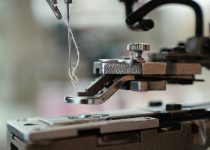Mastering the Mini Sewing Machine A Beginner’s Guide

Have you ever wished you could mend a torn pocket or create your own fashionable garments without having to deal with the hassle of a full-sized sewing machine? Look no further! In this comprehensive guide, we will show you how to operate a mini sewing machine like a pro. Whether you are a complete beginner or seeking to expand your sewing skills, this article will equip you with all the necessary knowledge to confidently tackle various sewing projects using a mini sewing machine. Let’s get started!
Getting to Know Your Mini Sewing Machine

Before we dive into the nitty-gritty of using a mini sewing machine, let’s start by familiarizing ourselves with the different parts and features. Here are a few key components you’ll find on most mini sewing machines:
Main Parts of a Mini Sewing Machine
- Spool Pin: This is where you place the thread spool that feeds the machine.
- Bobbin Winder: Used to wind the thread onto the bobbin.
- Bobbin Compartment: Houses the bobbin, which holds the bottom thread.
- Needle: The needle pierces the fabric, creating stitches.
- Presser Foot: Holds the fabric in place as it moves under the needle.
- Stitch Selector: Allows you to choose different stitch options.
- Tension Control: Regulates the tightness of stitches.
- Power Switch: Turns the machine on and off.
Now that we have familiarized ourselves with the basics, let’s move on to the next section, where we will walk you through the step-by-step process of setting up your mini sewing machine for a seamless sewing experience.
Setting Up Your Mini Sewing Machine

Step 1: Read the manual
“Before you dive into the world of sewing, take a moment to read the instruction manual provided with your mini sewing machine. It will guide you through the specific setup and operation steps tailored to your machine model.”
Step 2: Prepare your workspace
- Ensure you have enough space to comfortably work with your mini sewing machine.
- Place your sewing machine on a sturdy table or desk.
- Position a chair nearby for comfort.
Step 3: Prepare your materials
Gather the necessary materials before beginning your sewing project:
- Fabric
- Thread
- Bobbins
- Scissors
- Seam ripper (for removing stitches)
- Pins
Step 4: Threading the machine
To thread your mini sewing machine, follow these steps:
- Place the thread spool on the spool pin.
- Take the end of the thread and guide it through the thread guides, following the threading path shown in the manual.
- Thread the thread through the needle, leaving a few inches of thread hanging.
Step 5: Inserting the bobbin
Inserting the bobbin may vary slightly depending on your machine model. Refer to your manual for specific instructions. In most cases, the steps will be as follows:
- Open the bobbin compartment and place the bobbin inside.
- Pull the thread through the bobbin’s tension spring or guide.
- Leave a tail of thread hanging.
Step 6: Adjusting the tension
“Achieving the perfect tension is essential for producing neat and balanced stitches.”
To adjust the tension on your mini sewing machine:
- Consult your manual to locate the tension control dial.
- Experiment with different tension settings, starting with the recommended setting for your fabric type.
- Test the stitches on a scrap fabric to check if the tension is balanced.
Operating Your Mini Sewing Machine

Step 1: Lower the needle into the fabric
“Remember to always start sewing with the needle in the highest position.”
- Place your fabric under the presser foot, aligning the edge to the desired stitching line.
- Lower the presser foot onto the fabric.
- Manually rotate the handwheel towards you until the needle pierces the fabric and comes back up.
Step 2: Choosing the right stitch
Mini sewing machines offer a variety of stitching options. Here are some common stitches you can find:
- Straight stitch
- Zigzag stitch
- Buttonhole stitch
- Blind hem stitch
Refer to your manual for instructions on selecting the desired stitch.
Step 3: Sewing techniques
To achieve optimal results with your mini sewing machine, follow these sewing techniques:
- Keep a steady and controlled pace while guiding the fabric.
- Use pins to hold fabric pieces together before stitching.
- Backstitch at the beginning and end of each seam to secure the stitches.
- Take breaks and readjust the fabric if necessary to ensure smooth sewing.
Conclusion
Congratulations! You are now equipped with the knowledge and skills to operate a mini sewing machine effectively. By mastering the setup, threading, and operating techniques, you can unleash your creativity and embark on various sewing projects with confidence. Remember, practice makes perfect, so don’t hesitate to experiment and push your sewing skills further. Happy sewing!



